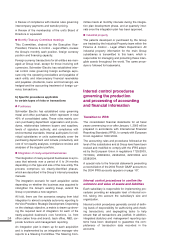APC 2004 Annual Report Download - page 38
Download and view the complete annual report
Please find page 38 of the 2004 APC annual report below. You can navigate through the pages in the report by either clicking on the pages listed below, or by using the keyword search tool below to find specific information within the annual report.
36
Long and short-term debt
Net debt is managed at Group level by the Finance &
Control - Legal Affairs Department. Where appropri-
ate, cash pooling agreements and currency position
management agreements are set up to profit from
economies of scale and minimize financing costs.
Decisions concerning the financing of subsidiaries
are made by the Finance & Control - Legal Affairs
Department. The bulk of their financing needs are met
by short-term intercompany loans in their local cur-
rency, but in some cases the Corporate Treasury
Center may decide to obtain external financing. Long-
term debt is managed at Group level.
Off-balance sheet commitments
The off-balance sheet commitments of newly-acquired
subsidiaries are reviewed and analyzed when the
company joins the Group. Financial guarantees are
issued by the Finance & Control - Legal Affairs
Department. A consolidated statement of off-balance
sheet commitments is produced at six-month intervals
by the Statutory and Management Accounting unit,
which performs analytical reviews to check the data.
Other legal commitments are tracked by the Legal
Affairs unit.
Procedures for the production
of accounting and financial information
The accounting system
Corporate Management Control and Accounting
Department of the Finance & Control - Legal Affairs
Department has launched a project to standardize
management reporting processes among the various
subsidiaries by rolling out an integrated SAP system
across the entire Group. Subsidiaries in France,
Spain, certain other European countries and China
have already migrated their statutory and manage-
ment accounting systems to SAP. A SAP core model
for use by all Group entities is currently being devel-
oped and will be implemented in phases between
2006 and 2009.
The accounts of the subsidiaries are prepared in
accordance with Group accounting policies. The data
is then adjusted, where necessary, to produce the
local statutory and tax accounts.
Consolidation software is used for statutory and man-
agement reporting purposes and also to produce the
Group financial statements. The main reporting pro-
cesses cover monthly actual and forecast data and
consolidation.
System design,
database and accounting standards
In order to prepare the switch to IFRS effective
January 1, 2005, since 2004 the Group has produced
two sets of accounts, in French GAAP and in IFRS.
The 2004 financial statements have been prepared in
accordance with French GAAP and include a recon-
ciliation to IFRS.
The consolidated financial statements comply with
the fundamental principles of fairness, consistent
application of accounting methods, segregation of
accounting periods, and separate recognition of
assets and liabilities. They are prepared on a going
concern basis using the historical cost convention.
Amounts reported in the closing balance sheet are
automatically taken up in the opening balance sheet
for the next period.
Group accounting policies take into account the forth-
coming adoption of IFRS by all European Union coun-
tries.
The management reporting and consolidation pack-
ages of all Group entities are prepared strictly in accor-
dance with Group accounting principles and policies.
Accounts closing process
The reporting units produce monthly income state-
ments, which are used to determine the Group's
monthly operating income.
Effective from 2003, the consolidated financial state-
ments are produced 16 working days after the annual
or half-yearly period-end. To meet this deadline, all of
the subsidiaries perform a hard close at May 31 and
November 30 of each year and the majority of con-
solidation adjustments for the period are also calcu-
lated at these dates. The related procedures include
the purchase accounting on acquisitions and the tax
charge.
Role of Corporate Management Control and
Accounting Department
The majority of subsidiaries are consolidated at Group
level; however, the Square D, Crouzet Automatismes
and MGE-UPS subgroups submit consolidated report-
ing packages.
The list of entities to be consolidated or accounted for
by the equity method is drawn up by Corporate Man-
agement Control and Accounting Department, which
then uses this list to determine with the Legal Affairs
unit the consolidation method to be applied to each
subsidiary, as well as the percentage of the sub-
sidiary's capital and voting rights held by the Group.
Corporate Management Control and Accounting
Department checks the quality of the reporting pack-
ages submitted by the subsidiaries, focusing primarily
on reconciliations between legal entities and reporting
entities, intercompany eliminations, the accounting
treatment of non-recurring transactions for the period,
and movements between the opening and closing bal-
ance sheet used to prepare the statement of cash flows.
The unit also checks the results of programmed pro-
cedures, including conversions, intercompany elimina-
tions, transfers to minority interests and recognition of
the effects of changes in scope of consolidation.
At the same time, the Group's consolidated financial
statements are analyzed in detail, to understand and
check the main contributions by subsidiaries, as well as
the substance of transactions reflected in the accounts.
























